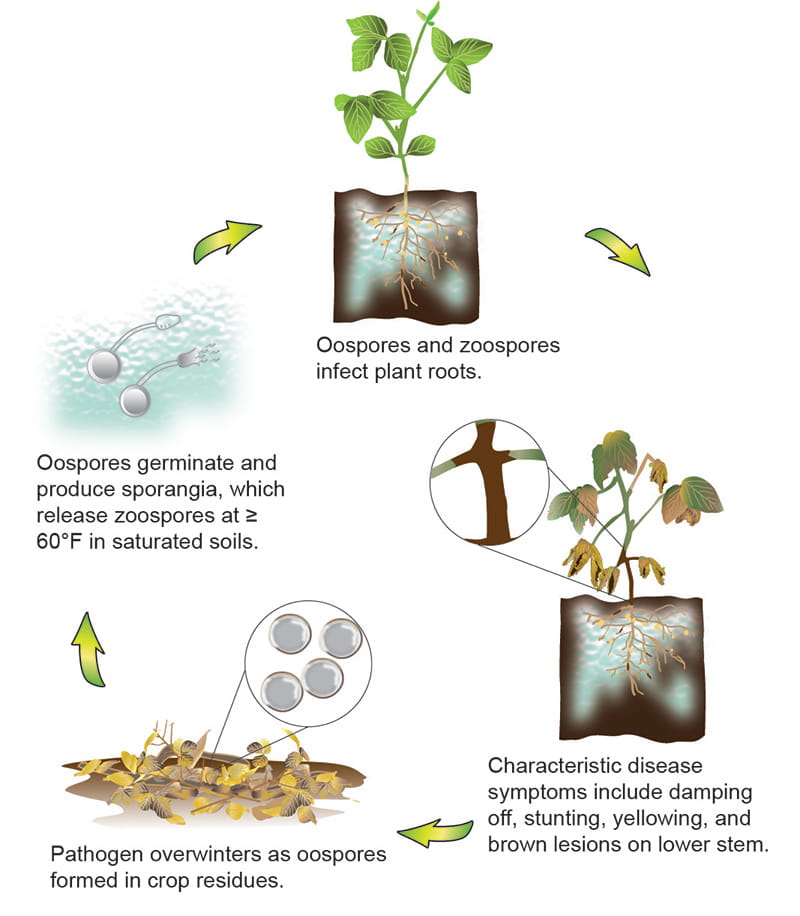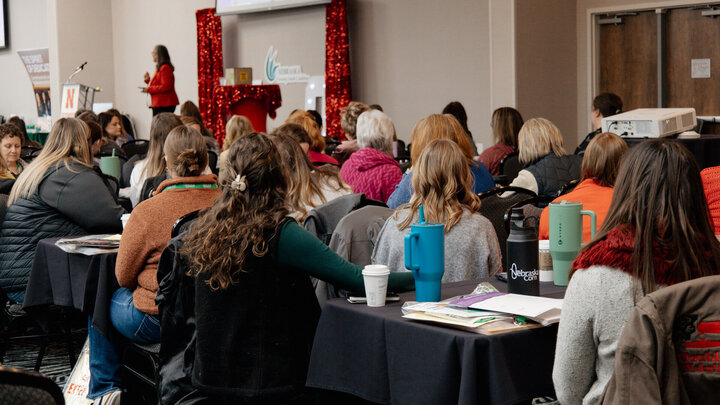By Loren J. Giesler, Former Extension Plant Pathologist, and Dylan Mangel, Extension Plant Pathologist
Pathogen
The soilborne oomycete Phytophthora sojae causes the soybean disease Phytophthora root and stem rot (PRSR). This is one of the most destructive soybean pathogens in the U.S. The organism has a history of evading overcoming resistance sources thanks to its great genetic diversity and is identified as different biotypes or races. Over the past 20 years we have observed a shift in the diversity of Phytophthora in Nebraska, with more areas having biotypes which are not affected by common resistance genes in soybean varieties.

This pathogen survives between seasons primarily as oospores, a type of resting spore, in the soil or in association with infested crop debris (Figure 1). The oospores germinate in wet spring soils, eventually forming numerous “swimming” zoospores that move through soil water to roots where they encyst and penetrate the epidermis of the root. The disease lifecycle is dependent on temporarily saturated soils, typically present during germination, or following heavy rain events throughout the season.
Disease Symptoms
Symptoms include stand reduction caused by seed rots or pre and post emergence damping off. Infected surviving seedlings exhibit water-soaked lesions on the stems and roots with yellowing and wilting of the leaves. The stem rot phase is easily identified by the dark brown color on the exterior surface of the stem and lower branches (Figure 2). This discoloration of the stem extends from below the soil to 6 inches or more above the soil line. The taproot turns dark brown and the entire root system may be rotted. Leaves on older infected plants become chlorotic between the veins followed by general wilting and death.

Post-emergence damping off caused by P. sojae can be differentiated from that caused by Pythium spp. after the V2 growth stage as Phytophthora-infected seedlings will have brown discoloration extending up the stem from the root, whereas Pythium damping off is found at the hypocotyl and below. Plants may be killed in pockets in the field or large areas may be affected (Figure 3).

Favorable Environmental Conditions
Disease development is most rapid at soil temperatures above 60° F and high soil moisture. It is most common in low areas of a field, on poorly drained or compacted soils, and in soils with high clay content, although it is not limited only to these sites or conditions. It may also occur on well-drained hillsides during wet growing seasons.
Management
Genetic Resistance
Using resistant varieties is the most effective way to manage Phytophthora root and stem rot of soybean. Genetic resistance in the host is expressed in terms of Rps ("resistance to Phytophthora sojae") genes. The race-specific genes offer complete resistance to a specific race of P. sojae and genes are denoted as Rps 1a, 1b, 1c,1d,1k, 3,6,7. The pathogen exists in races or biotypes that interact with these genes. In a resistant reaction, the plant survives infection; susceptible varieties are killed when infection occurs. Race-specific resistance is effective in the early stages of germination.
The other parameter on which soybean varieties are rated for P. sojae is partial resistance (also called field resistance or tolerance). Soybean varieties with high levels of partial resistance can become infected with P. sojae but the symptoms are not as severe as highly susceptible varieties. In field research trials conducted in Nebraska, good partial resistance performed as well as varieties with resistance genes and partial resistance. In fields where the P. sojae biotype is aggressive against the resistance genes available in commercial varieties, this is the only choice for management with genetics. If possible, a combination of good partial resistance and an Rps gene is recommended. Partial resistance alone will not be as effective during early growth stages or under high disease pressure.
Cultural Practices
Anything that can be done to improve soil drainage and structure will reduce disease potential. In many cases tilling can improve soil drainage. Compacted soils will also result in increased disease levels. Crop rotation should also be done, as continuous soybean production will increase fungal inoculum and promote development of new biotypes or races.
Chemical/Biological Control
Seed treatment fungicides containing mefenoxam or metalaxyl should be used in fields with a history of this disease. Note that many products require increased rates for activity against Phytophthora. See the UNL NebGuide link below for additional seed treatment information.
Additional Resources
- Nebraska Extension NebGuide Seed Treatment Fungicides for Soybeans, G1852
- Nebraska Extension NebGuide Management of Phytophthora Root and Stem Rot of Soybeans, G1785
- Crop Protection Network: Phytophthora Root and Stem Rot
- North Central Soybean Research and Information Initiative: Phytophthora Root and Stem Rot
Soybean Diseases
- Soybean Diseases (Home)
- Anthracnose
- Bacterial Blight
- Bacterial Pustule
- Bean Pod Mottle Virus
- Brown Spot
- Brown Stem Rot
- Charcoal Rot
- Frogeye Leaf Spot
- Phytophthora Root and Stem Rot
- Pod and Stem Blight
- Purple Seed Stain
- Rhizoctonia Root Rot
- Sclerotinia Stem Rot
- Soybean Cyst Nematode (SCN)
- Soybean Mosaic Virus
- Soybean Rust
- Stem Canker
- Sudden Death Syndrome (SDS)








